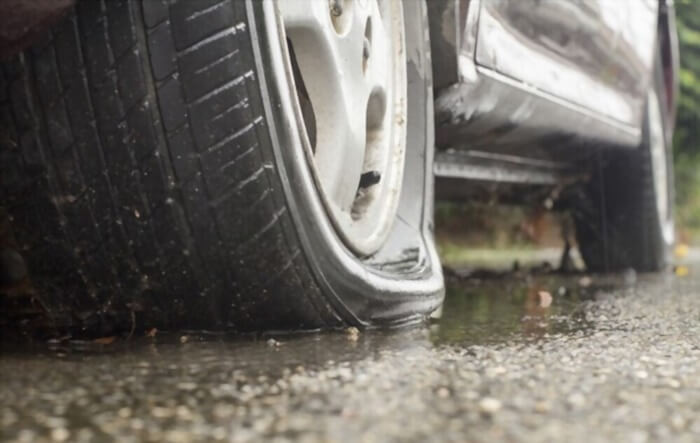Most individuals use the terms “flat tire” and “deflated tire” interchangeably, but there is a difference between the two. A flat tire is one that has lost all of its air, either through a puncture or slow leakage. On the other hand, a deflated tire simply has less air than is recommended by the manufacturer.
While a flat tire will need to be repaired or replaced, a deflated tire can often be re-inflated to its proper level. Thus, it is essential to check your tires regularly to ensure that they are correctly inflated. Doing so can help to extend their lifespan and prevent costly repairs down the road.
What Causes a Flat Tire
Punctures
Due to the frequency with which construction materials like screws and nails, glass, and sharp objects fall from moving trucks using the roads, tire punctures are the most prevalent cause of flat tires. Removing debris from your driveway and yard is a fantastic method to stop this, as is driving while avoiding any dangerous materials on the road.
Damaged Roadways
Every day, over 250 million automobiles use the roads in America. Although around 11,000 individuals die while driving on dangerous roads, vehicle damage is more likely to be to blame.
According to experts, 63 percent of Americans cannot quickly afford car repairs to replace rims, tires, shocks, catalytic converters, or suspension systems due to the average cost of repairs caused by damaged roads, which is roughly $377.

Wear and Tear
Wear and tear are frequently the cause of flat tires because every motorist wants to get the most mileage out of their car tires before they can replace them.
The National Highway Traffic Safety Administration discovered that one in ten drivers had bald tires and that half of the motorists on American roadways had tires with at least half of their tread worn off. Due to its ability to create hydroplaning, this condition is fatal on the road. There is a good chance that your car will sustain damage if your tires are worn.
What Causes a Deflated Tire
Underinflation
Underinflation is one of the most frequent reasons for a deflated tire. By routinely checking your tires’ tire pressure, you may prevent this.
Temperature Variations
Temperature variations are another frequent cause. This is because the air inside your car tires expands in hot weather and contracts in cold weather. The tire pressure may change as a result of this.
How Do You Know if You Have a Flat or Deflated Tire?
There are a few tell-tale signs that you have a flat or deflated tire. If you notice that your car is pulling to one side, you likely have a flat. Another clue is if you hear a thumping noise as you drive; this is usually the tire hitting the ground.
Finally, if you see that your tire is low on air, it’s time to inflate it or replace the tire. If you’re unsure how to do this, you can always take it to a professional. They will be able to quickly assess the situation and get you back on the road in no time.
How to Fix a Flat Tire EASY (Everything you need to know) VIDEO!!
What are the Consequences of Having a Flat or Deflated Tire?
A tire that is not correctly inflated can cause several problems for a vehicle. First, it can lead to premature wear on the tire and may cause the tread to separate from the tire. This can be extremely dangerous, as it can cause the tire to blow out while the vehicle is in motion.
Additionally, a flat or deflated tire can adversely affect gas mileage. When a tire is not correctly inflated, it increases rolling resistance, which causes the engine to work harder and use more fuel.
In addition, a flat or deflated tire can strain other parts of the vehicle, such as suspension and alignment. As a result, it is vital to regularly check the inflation of all tires to ensure the safe and efficient operation of the vehicle.
How Can You Prevent Your Tires from Becoming Flat or Deflated in the First Place?
You can do a few things to help prevent your tires from becoming flat or deflated in the first place. First, make sure you keep your tires properly inflated. This will help reduce the friction between your car tire and the road, which can lead the tire to lose air over time.
Secondly, avoid driving over sharp objects or potholes. This can damage the tire and cause it to leak air. Finally, have your tires regularly inspected by a professional to ensure they are in good condition. These simple steps can help extend your tires’ life and avoid costly repairs or replacements.
What to Do After Experiencing a Flat or Deflated Tire?
If you experience a flat or deflated tire, you should first locate a safe location and stop. After pulling over, you’ll need to assess the situation. If the car tire is visibly damaged, such as a large puncture, it will need to be replaced.
However, if your car tire is simply low on air, you may be able to inflate it using a portable air compressor. Once you’ve addressed the FLAT tire, you can get back on the road. But be sure to drive slowly and carefully until you can get the tire repaired or replaced by a professional.
What Takes Place If You Continue Driving on a Flat Tire?
Driving on a flat tire for too long can harm both the tire and the wheel. The car may also begin to pull to one side as a result. Additionally, it can result in a blowout, which might be harmful.
A blowout occurs when a tire ruptures due to an impact or pressure shift that occurs suddenly. This puts the vehicle out of control and is extremely risky.
What does tyre deflated mean?
Tyre deflated means that the air pressure inside the tire has dropped below the recommended level. This can cause the tire to lose its shape, resulting in a lower profile and less grip on the road. A deflated tire can lead to poor handling, longer stopping distances, and decreased fuel efficiency. It is important to maintain proper tire pressure to ensure the safety and performance of a vehicle.
Do puncture resistant bike tires work ?
Yes, puncture-resistant bike tires can effectively reduce the chances of getting a flat tire caused by small objects such as thorns, glass, or sharp rocks that can penetrate the tire. However, it’s important to note that no tire is completely puncture-proof. The level of resistance varies among different brands and models, and it depends on the tire’s construction and the materials used. Additionally, other factors such as tire pressure, road conditions, and riding style can also affect the likelihood of getting a flat tire. Nevertheless, puncture-resistant bike tires can provide an extra layer of protection and give you peace of mind while riding.
Wrap Up
We hope this article has helped you understand the differences between a flat and deflated tire. To prevent your tires from being flat or deflated, inflate them to the required pressure, avoid driving over sharp objects, and have them regularly checked by a professional.
